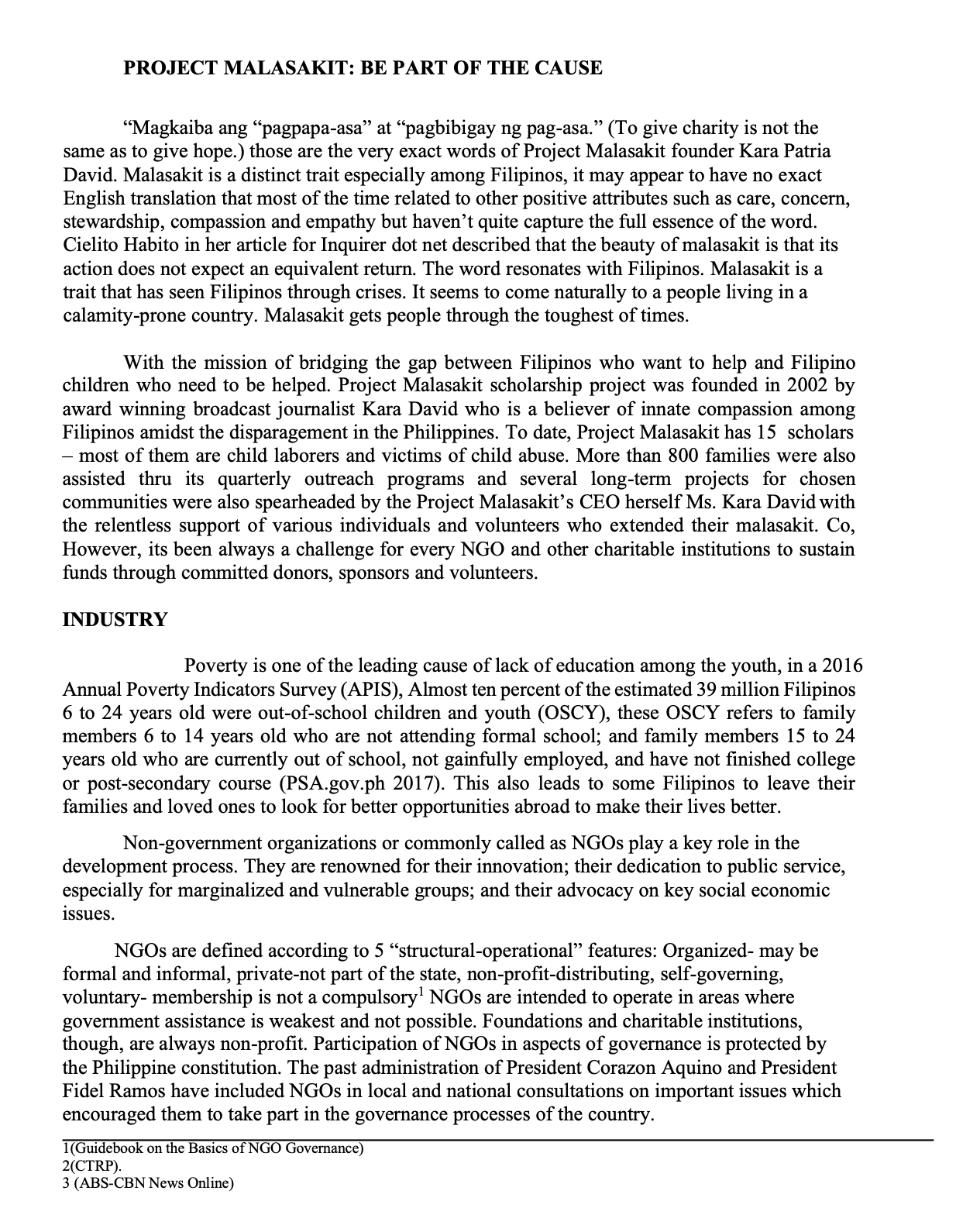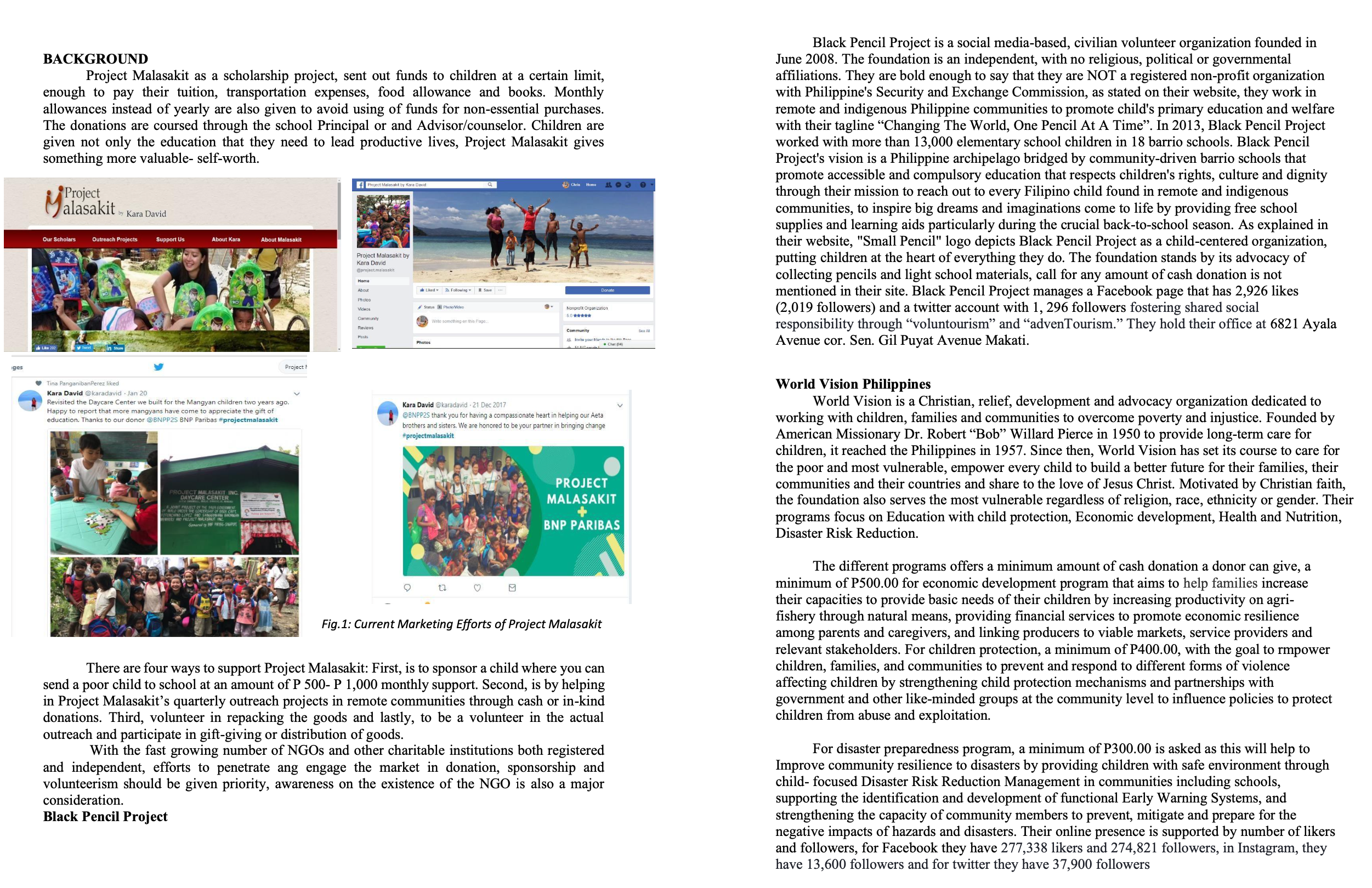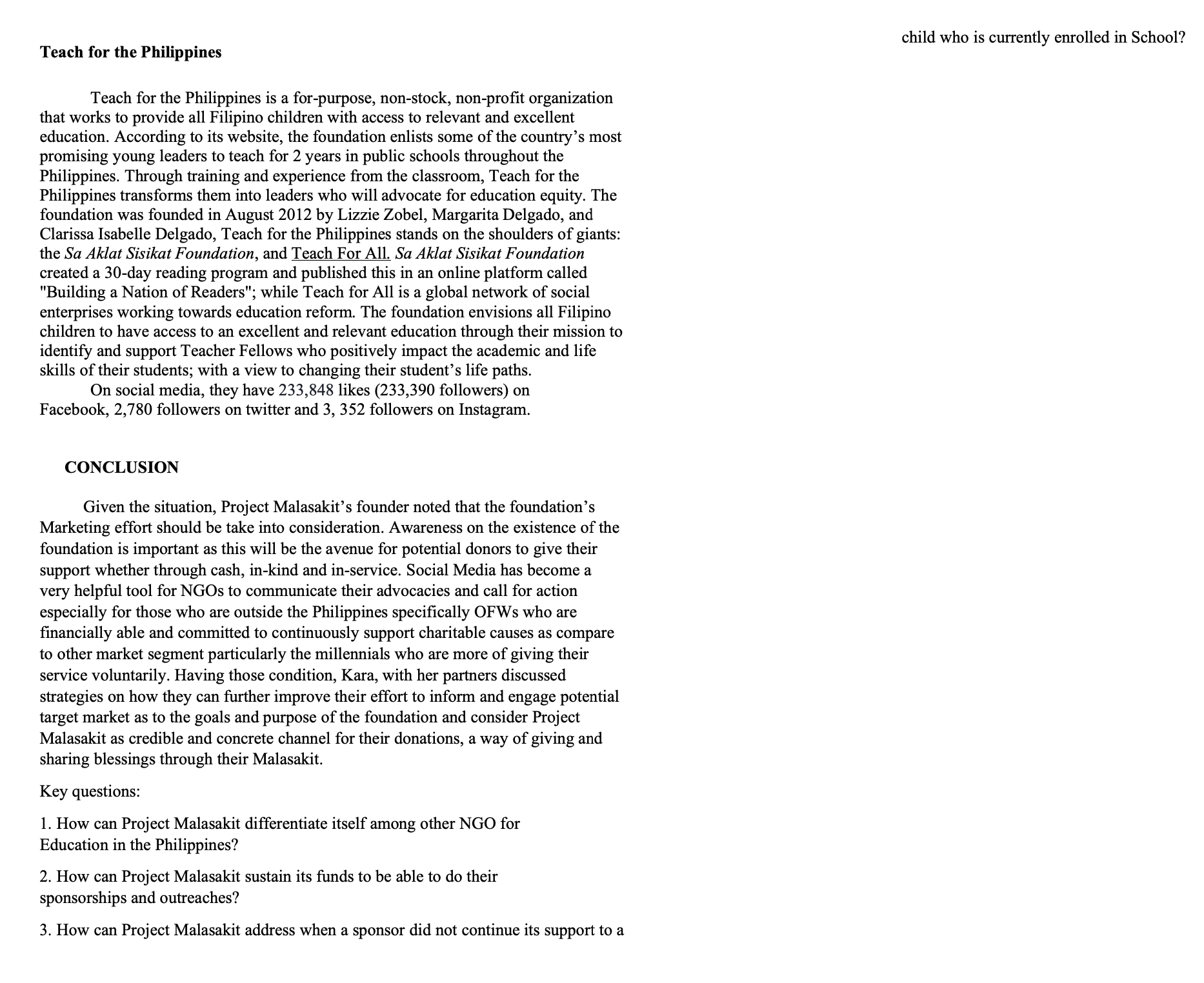What is the statement of the problem of this case study?
PROJECT MALASAKIT: BE PART OF THE CAUSE "Magkaiba ang "pagpapa-asa" at "pagbibigay ng pag-asa." (To give charity is not the same as to give hope. ) those are the very exact words of Project Malasakit founder Kara Patria David. Malasakit is a distinct trait especially among Filipinos, it may appear to have no exact English translation that most of the time related to other positive attributes such as care, concern, stewardship, compassion and empathy but haven't quite capture the full essence of the word Cielito Habito in her article for Inquirer dot net described that the beauty of malasakit is that its action does not expect an equivalent return. The word resonates with Filipinos. Malasakit is a trait that has seen Filipinos through crises. It seems to come naturally to a people living in a calamity-prone country. Malasakit gets people through the toughest of times. With the mission of bridging the gap between Filipinos who want to help and Filipino children who need to be helped. Project Malasakit scholarship project was founded in 2002 by award winning broadcast journalist Kara David who is a believer of innate compassion among Filipinos amidst the disparagement in the Philippines. To date, Project Malasakit has 15 scholars - most of them are child laborers and victims of child abuse. More than 800 families were also assisted thru its quarterly outreach programs and several long-term projects for chosen communities were also spearheaded by the Project Malasakit's CEO herself Ms. Kara David with the relentless support of various individuals and volunteers who extended their malasakit. Co, However, its been always a challenge for every NGO and other charitable institutions to sustain funds through committed donors, sponsors and volunteers. INDUSTRY Poverty is one of the leading cause of lack of education among the youth, in a 2016 Annual Poverty Indicators Survey (APIS), Almost ten percent of the estimated 39 million Filipinos 6 to 24 years old were out-of-school children and youth (OSCY), these OSCY refers to family members 6 to 14 years old who are not attending formal school; and family members 15 to 24 years old who are currently out of school, not gainfully employed, and have not finished college or post-secondary course (PSA.gov.ph 2017). This also leads to some Filipinos to leave their families and loved ones to look for better opportunities abroad to make their lives better. Non-government organizations or commonly called as NGOs play a key role in the development process. They are renowned for their innovation; their dedication to public service, especially for marginalized and vulnerable groups; and their advocacy on key social economic issues . NGOs are defined according to 5 "structural-operational" features: Organized- may be formal and informal, private-not part of the state, non-profit-distributing, self-governing, voluntary- membership is not a compulsory' NGOs are intended to operate in areas where government assistance is weakest and not possible. Foundations and charitable institutions, though, are always non-profit. Participation of NGOs in aspects of governance is protected by the Philippine constitution. The past administration of President Corazon Aquino and President Fidel Ramos have included NGOs in local and national consultations on important issues which encouraged them to take part in the governance processes of the country. 1 (Guidebook on the Basics of NGO Governance) 2(CTRP). 3 (ABS-CBN News Online)To ensure that the resources received by NGOs are being used for their declared goals and objectives, the government through Department of Finance (DOF) initially recommend that only donations to the government's disaster relief program be tax-deductible when it rst submitted its draft Comprehensive Tax Reform Package2 .A nonprot organization may seek additional tax benets by becoming an accredited nonstock, nonprot corporation or an \"accredited N .\" This certication vests the organization with donee institution status, which entitles it to receive tax-deductible donations. In the case of an accredited nonstock, nonprot corporation, donations are deductible up to 5% of taxable income for corporate donors and 10% for individual donors. In the Philippines, Civil Society Organizations secure their funding through membership dues, donations, subsidies and revenue from income-generated activities. As mentioned by Project Malasakit's founder, the Overseas Filipino Workers (OFW) has a big contribution to the foundation in terms of cash donations which supports which supports the fact that remittances of our OFWs serves as one of the main drivers of the economy. According to John Paolo Rivera, an economic consultant, Filipinos has a culture of migration and he do not see it waning, together with remittances in the short to medium run. Also, the think tank HSBC Global said in the report "How resilient: Remittances to remain a driver of Philippine growth." States that, Remittance growth has been remarkably resilient over the years, shrugging off both financial crises and economic slowdowns. Remittances drive private consumption which accounts for almost 75 percent of the Philippine gross domestic product (GDP). With regards to cash donations coming from overseas, the Bureau of Internal Revenue pointed out that no donor's tax is imposed on cash from overseas same for local cash donations given to accredited foundations. Donors can also deduct their donations from their income. However, cash donations made to organizations that are not accredited with the departments like Department of Social Welfare and Development and NDRRMC may be taxed. As for in-kind donations sent from abroad, the BIR chief reiterated that duty-exemption is given to those donations sent to DSWD, NDRRMC and other accredited relief organizations3 Also, in an online article published by ABS-CBN, the Commission on overseas Filipinos has pegged the number of Filipinos working or living permanently abroad at more than 10 million, as of end 2013. That translates to 12 to 15 million, including the undocumented OFWs, according to Migrante International, a militant labor organization. Because of their sheer, through their dollar remittances, helped boost the Philippine economy and contributed signicantly in making the economy resilient from external shocks, according to analysts. In terms of number of Overseas Filipino Workers (OFWs) who worked abroad during the period April to September 2016, Philippine Statistics Authority reported an estimate of 2.2 million. Overseas Contract Workers (OCWs) or those with existing work contract comprised 97.5 percent of the total OFWs during the period April to September 2016. The rest (2.5 %) worked overseas without contract. Data also shows that there were more females than males among the OFWs, comprising 53.6 percent of the total OFWs. Female OFWs were generally younger than male OFWs, with more than two-thirds (67.8%) of the female OFWs belonging to the age group 25 to 39 years. In comparison, male OFWs in this age group made up 57.4 percent. Male OFWs aged 45 years and older accounted for 23.9 percent of all male OFWs while their female counterparts in this age group made up 13.8 percent. Among occupation groups, elementary occupations (34.5%) comprised the largest group followed by those who worked as service and sales workers (19.0% , plant and machine operators and assemblers (12.8% , and craft and related trades workers (11.6%) . Central Luzon with 12.9 percent and 12.7 percent, respectively. Forty-seven percent of the total OFWs came from these three regions. Meanwhile, Cordillera Administrative Region reported the least share of OFWs at 1.8 percent Since then, Saudi Arabia continued to be the leading destination of OFWs. About one in every four (23.8%) OFWs worked in this country during the period April to September2016. The other preferred destinations were United Arab Emirates (15.9%), Europe (6.6%), Kuwait (6.4%), and Qatar (6.2%) The total remittance sent by OFWs during the period April to September 2016 was estimated at 203.0 billion pesos. These remittances included cash sent home (146.0 billion pesos), cash brought home (45.7 billion pesos) and remittances in kind (11.1 billion pesos). The majority of OFWs sent their remittance through banks (60.3%) while the rest through agencies or local ofces (2.4%), door-todoor delivery (1.2%), friends or co-workers (0.3%) or through other means (35.8%) The remittances sent by OFWs to their respective families may just be a part of the total salary received by the OFWs. Data on remittances in this report are based on the answers given by the survey respondents to the questions on how much cash remittance was received by the family during the period April to September 2016 from a family member who is an OFW and how much cash did this member bring home during the reference period, if any. Further, if the family received during the reference period goods and products sent by this OFW, the imputed value of such goods was included in his/her total remittance. of the total cash remittance sent by OFWs, the remittance sent by elementary occupations comprised the biggest share at 21.9 percent or 31.9 billion pesos, or an average remittance of 48 thousand pesos per OFW who an unskilled worker. The total remittance of OFWs working in Asia, comprising 850 percent of all OFWs, accounted for 79.5 percent of the total cash remittances. From other countries, the percentage shares are as follows, Europe (8.8% , North and South Africa (7.3%), Australia (2.2%) and Africa (2.1%). 4' 4(psa.gov.ph, 2016) Black Pencil Project is a social media-based, civilian volunteer organization founded in BACKGROUND June 2008. The foundation is an independent, with no religious, political or governmental Project Malasakit as a scholarship project, sent out funds to children at a certain limit, affiliations. They are bold enough to say that they are NOT a registered non-profit organization enough to pay their tuition, transportation expenses, food allowance and books. Monthly with Philippine's Security and Exchange Commission, as stated on their website, they work in allowances instead of yearly are also given to avoid using of funds for non-essential purchases. remote and indigenous Philippine communities to promote child's primary education and welfare The donations are coursed through the school Principal or and Advisor/counselor. Children are with their tagline "Changing The World, One Pencil At A Time". In 2013, Black Pencil Project given not only the education that they need to lead productive lives, Project Malasakit gives worked with more than 13,000 elementary school children in 18 barrio schools. Black Pencil something more valuable- self-worth. Project's vision is a Philippine archipelago bridged by community-driven barrio schools that promote accessible and compulsory education that respects children's rights, culture and dignity Project f Project Malas atd by Kara Dev through their mission to reach out to every Filipino child found in remote and indigenous Jalasakit , Kara David communities, to inspire big dreams and imaginations come to life by providing free school supplies and learning aids particularly during the crucial back-to-school season. As explained in Our Scholars Outreach Projects Support Us About Kara About Malasakit heir website, "Small Pencil" logo depicts Black Pencil Project as a child-centered organization, Project Malasakit by Kara David putting children at the heart of everything they do. The foundation stands by its advocacy of setmalasak collecting pencils and light school materials, call for any amount of cash donation is not Lived " . Following A Save mentioned in their site. Black Pencil Project manages a Facebook page that has 2,926 likes States * Photo/Video Nonprofit Organization (2,019 followers) and a twitter account with 1, 296 followers fostering shared social rite something on this Page Community responsibility through "voluntourism" and "adventourism." They hold their office at 6821 Ayala Avenue cor. Sen. Gil Puyat Avenue Makati. Project Tina PanganibanPerez liked World Vision Philippines Kara David @karadavid . Jan 20 Revisited the Daycare Cent Daycare Center we built for the Mangyan children two years ago. Happy to report that more mangyans have come to appreciate the gift of Kara David @karadavid . 21 Dec 2017 World Vision is a Christian, relief, development and advocacy organization dedicated to education. Thanks to our donor @BNPP2S BNP Paribas #projectmalasakit @BNPP2S thank you for having a compassionate heart in helping our Aeta brothers and sisters. We are honored to be your partner in bringing change working with children, families and communities to overcome poverty and injustice. Founded by #projectmalasakit American Missionary Dr. Robert "Bob" Willard Pierce in 1950 to provide long-term care for children, it reached the Philippines in 1957. Since then, World Vision has set its course to care for the poor and most vulnerable, empower every child to build a better future for their families, their PROJECT communities and their countries and share to the love of Jesus Christ. Motivated by Christian faith, DAYCARE CENTER MALASAKIT the foundation also serves the most vulnerable regardless of religion, race, ethnicity or gender. Their BNP PARIBAS programs focus on Education with child protection, Economic development, Health and Nutrition, Disaster Risk Reduction. The different programs offers a minimum amount of cash donation a donor can give, a O minimum of P500.00 for economic development program that aims to help families increase their capacities to provide basic needs of their children by increasing productivity on agri Fig. 1: Current Marketing Efforts of Project Malasakit fishery through natural means, providing financial services to promote economic resilience among parents and caregivers, and linking producers to viable markets, service providers and relevant stakeholders. For children protection, a minimum of P400.00, with the goal to rmpower There are four ways to support Project Malasakit: First, is to sponsor a child where you can children, families, and communities to prevent and respond to different forms of violence send a poor child to school at an amount of P 500- P 1,000 monthly support. Second, is by helping affecting children by strengthening child protection mechanisms and partnerships with in Project Malasakit's quarterly outreach projects in remote communities through cash or in-kind government and other like-minded groups at the community level to influence policies to protect donations. Third, volunteer in repacking the goods and lastly, to be a volunteer in the actual children from abuse and exploitation. outreach and participate in gift-giving or distribution of goods. With the fast growing number of NGOs and other charitable institutions both registered For disaster preparedness program, a minimum of P300.00 is asked as this will help to and independent, efforts to penetrate ang engage the market in donation, sponsorship and Improve community resilience to disasters by providing children with safe environment through volunteerism should be given priority, awareness on the existence of the NGO is also a major child- focused Disaster Risk Reduction Management in communities including schools, consideration. supporting the identification and development of functional Early Warning Systems, and Black Pencil Project strengthening the capacity of community members to prevent, mitigate and prepare for the negative impacts of hazards and disasters. Their online presence is supported by number of likers and followers, for Facebook they have 277,338 likers and 274,821 followers, in Instagram, they have 13,600 followers and for twitter they have 37,900 followersTeach for the Philippines Teach for the Philippines is a forpurpose, nonstock, nonprot organization that works to provide all Filipino children with access to relevant and excellent education. According to its website, the foundation enlists some of the country's most promising young leaders to teach for 2 years in public schools throughout the Philippines. Through training and experience from the classroom, Teach for the Philippines transforms them into leaders who will advocate for education equity. The foundation was founded in August 2012 by Lizzie Zobel, Margarita Delgado, and Clarissa Isabelle Delgado, Teach for the Philippines stands on the shoulders of giants: the So Aklat 3115'th Foundation, and Teach For All. So Aldo! Sisikat Foundation created a 30day reading program and published this in an online platform called "Building a Nation of Readers"; while Teach for Allis a global network of social enterprises working towards education reform, The foundation envisions all Filipino children to have access to an excellent and relevant education through their mission to identify and support Teacher Fellows who positively impact the academic and life skills of their students; with a view to changing their student's life paths. 0n social media, they have 233,848 likes (233,390 followers) on Facebook, 2,780 followers on twitter and 3, 352 followers on Instagram. CONCLUSION Given the situation, Project Malasakit's founder noted that the foundation's Marketing effort should be take into consideration. Awareness on the existence of the foundation is important as this will be the avenue for potential donors to give their support whether through cash, in-kind and inservice. Social Media has become a very helpful tool for NGOs to communicate their advocacies and call for action especially for those who are outside the Philippines specically OFWs who are nancially able and committed to continuously support charitable causes as compare to other market segment particularly the millennials who are more of giving their service voluntarily. Having those condition, Kara, with her partners discussed strategies on how they can further improve their e'ort to inform and engage potential target market as to the goals and purpose of the foundation and consider Project Malasakit as credible and concrete channel for their donations, a way of giving and sharing blessings through their Malasakit. Key questions: 1. How can Project Malasakit differentiate itself among other NGO for Education in the Philippines? 2. How can Project Malasakit sustain its funds to be able to do their sponsorships and outreaches? 3. How can Project Malasakit address when a sponsor did not continue its support to a child who is currently enrolled in School










